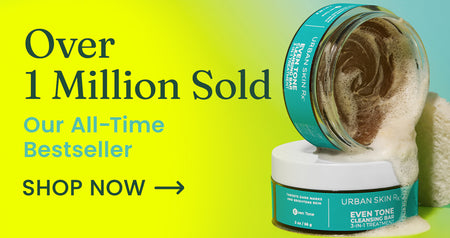Mineral vs. Chemical Sunscreen: Which Is Better?

It’s getting warmer, so it’s almost time for beach vacations and outdoor activities. You already know that sunscreen will save your skin, but you’re still missing one piece of vital information: which sunscreen is best for you?
As it turns out, this seemingly simple question has quite a complicated answer. There are two main types of sunscreen: mineral sunscreen and chemical sunscreen. Each type has its own pros and cons, and we’re here to help you figure out which is best for you. How Do Sunscreens Work?
Basically, sunscreen protects your skin from sun damage and its consequences, such as wrinkles and fine lines, age spots, dark spots and irritation. Sunscreen is designed to protect your skin from UVB rays, which can cause dangerous sun damage.
Some sunscreens also protect your skin from UVA rays, which are responsible for sunburn. Sunscreens that protect your skin from both types of rays are called “broad-spectrum,” and should say it on their labels.
While you might think you only need sunscreen when it’s hot out, you should be wearing sunscreen year-round. Reflective surfaces like snow can heighten your sun exposure, ultimately leading to sun damage if you aren’t wearing sunscreen. Even when it’s cloudy, you can be exposed to 80% of the sun’s harmful UV rays.
You should also wear sunscreen when indoors. UVA rays can’t travel through windows, so you won’t burn as long as you're inside. However, UVB rays can pass through windows. While you may not see physical evidence of sun exposure when you’re inside, your skin can still get damaged if you aren’t wearing sunscreen.
While no sunscreen can provide 100% protection against sun rays, studies have shown that a Sun Protection Factor (SPF) of 30 can protect you from 97% of harmful sun exposure. Because of this, dermatologists recommend that you wear at least SPF 30.
What Is Mineral Sunscreen?
Mineral sunscreen is made up of all-natural ingredients like Zinc Oxide and Titanium Dioxide. These minerals sit on top of the skin and reflect sun rays so they don’t get near your skin.
Mineral sunscreens like our SheerGlow™ Even Tone Daily Defense Moisturizer SPF 30 act more as a physical barrier to sun damage. Because of this, mineral sunscreen is sometimes referred to as physical sunscreen or sunblock.
Sunscreens made from mineral formulas are often marketed toward children because of their all-natural and skin-sensitive qualities. They’re also recommended for pregnant women because they are less harsh.
What Is Chemical Sunscreen?
Chemical sunscreen uses chemicals like Oxybenzone, Avobenzone, Octisalate, Octocrylene, Homosalate and Octinoxate to protect your skin from harmful ultraviolet rays. These chemicals absorb into your skin and work by converting UV rays into heat and releasing them from your skin.
Chemical sunscreens account for most of what you see in the store since they are easier to use and feel lighter on the skin. They also come in a wider variety of formats, which can be more convenient for some people.
What Are Some Benefits of Mineral and Chemical Sunscreens?
Mineral and chemical sunscreens may seem similar, but they actually have a few key differences that you should know.
Pros of Mineral Sunscreen
Mineral sunscreen is a great fit for anyone who has sensitive or blemish-prone skin. The formulas are generally free from irritating ingredients and keep the sun off your skin. Many mineral sunscreen products have a thicker texture, which can help moisturize dry skin.
A sunscreen based on minerals can also protect against UVB light that comes in through windows, and it works immediately after application. This way, there’s no pesky waiting period. This is especially helpful for children, who often can’t wait to get out and have some fun in the sun.
Cons of Mineral Sunscreen
Although there’s a lot to love about mineral sunscreen, it does have some cons. Mineral sunscreen is often harder to apply because of its thicker formula and doesn’t absorb into the skin as well.
Because it doesn’t absorb all the way into the skin, mineral sunscreen often results in a whitish tint while using. This may be an issue for those with darker skin tones. If you have this issue, some mineral sunscreens use tinted zinc oxide to help minimize the white cast of the product.
Our SheerGlow™ Even Tone Daily Defense Mineral Moisturizer contains effective mineral active ingredients without causing a white cast, even on darker skin tones — all thanks to our finely milled Zinc Oxide that is invisible on skin once applied.
Another con to mineral sunscreen is that it doesn’t last as long when exposed to sweat or water. If you’re using mineral sunscreen on the beach, you may need to reapply more often.
Pros of Chemical Sunscreen
On the other hand, chemical sunscreens are easier to find in stores. They typically use lightweight formulas that aren’t sticky or greasy and can be much more comfortable to wear than mineral sunscreens.
Chemical sunscreen is easier to apply and often absorbs into the skin without much effort on the wearer’s part. This type of sunscreen is also more water-resistant, which means you can go longer in-between applications.
Cons of Chemical Sunscreen
Chemical sunscreens have a few downsides as well. These sunscreens use ingredients that can aggravate sensitive skin and cause blemishes in blemish-prone skin. They are also more likely to cause discomfort.
Chemical sunscreen also takes longer to come into effect. After applying, it is recommended to wait 20-30 minutes before going out in the sun.
If you want the advantages of both a mineral and chemical sunscreen without the cons, our hydrating Complexion Protection Moisturizer With SPF 30 contains both mineral and chemical actives.
Is One Type Safer Than the Other?
The Food and Drug Administration (FDA) has approved mineral sunscreen and chemical sunscreen for use and has marked them both safe for use and effective at blocking harmful UV radiation. However, the FDA recently requested more research on some of the active ingredients in most chemical sunscreens. They haven’t been declared unsafe, but they do need a bit more research.
This is because scientists recently found that these chemicals can enter the bloodstream after only one application and can remain in the bloodstream for up to three weeks. The FDA hasn’t said that this is a bad thing but wants to know more about these sunscreen ingredients that can stay in the body for so long.
If you’re pregnant or planning to become pregnant, you may want to steer clear of chemical sunscreen until the FDA has further information. That said, mineral sunscreen is perhaps the safest, but as long as you protect your skin from sun exposure, the best sunscreen is any sunscreen.
Tips for Using Mineral Sunscreen or Chemical Sunscreen
Using sunscreen requires so much more than just applying it at the end of your morning skincare routine; it’s a daily commitment. Here are a few ways to get the most out of your sunscreen.
Check Your Skin TypeYour sunscreen should serve your skin type. If you have dry skin, you’ll want a creamy lotion-like formula that will hydrate your skin and provide broad-spectrum protection at the same time.
Meanwhile, you’ll need a lightweight, non-comedogenic formula if you have oily skin. Non-comedogenic just means that the product won’t clog your pores and, therefore, will cause less skin irritation and have less potential to cause blemishes.
We recommend our ShineBlock™ Oil Control Moisturizer SPF 30 for our glowgetters with oily skin. This Oprah-approved formula is lightweight and won’t clog your pores. It simultaneously moisturizes and protects while also wicking away excess oil. It’s one of the best things you could put on your oily skin!
Reapply and Stay in the ShadeAs we said before, no sunscreen provides 100% sun protection. The best way to protect against the sun is to stay in the shade and avoid going out in the sun between 10 am and 2 pm, when you are most vulnerable to sun damage. When possible, remain indoors to keep your skin glowing and healthy-looking.
If you are not able to stay inside or stay in the shade, make sure you reapply broad-spectrum SPF every two hours, or as directed on the product’s package. While chemical sunscreen ingredients are more resistant to water, mineral sunscreen will rub off faster — so you’ll need to reapply mineral sunscreen a bit more frequently.
Make sure you apply your sunscreen liberally, or else you won’t get the full amount of SPF the product is designed to give. The average adult should use 1 oz, or one shot glass, full of sunscreen to cover their body. And make sure to cover exposed areas such as the ears, neck and backs of hands.
Check Your ClothingWhile clothing can act as a barrier between your skin and UV light, not all clothing is created equal.
You should make sure your clothing provides adequate protection against harmful sun rays. Some clothing is even treated for maximum protection.
You should also wear hats to protect your scalp from the sunlight. If that’s not quite your style, we get it. But, you should at least apply sunscreen to the vulnerable areas of your scalp to protect it against the sun.
The Bottom Line
Mineral sunscreen is made with all-natural ingredients that are less likely to cause irritation, but it is also harder to apply. On the other hand, chemical sunscreen is easier to apply, but the chemicals may irritate blemish-prone skin. Both types of sunscreen are effective against harmful UV rays, and which type of formula you choose is ultimately up to your personal preferences.
For more tips and tricks on how to use your favorite skincare products, check out our glow-up guide and follow us on social media!
Service Representative




